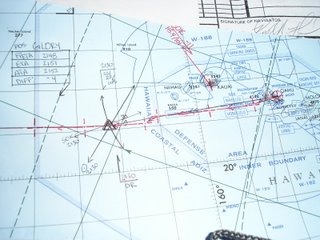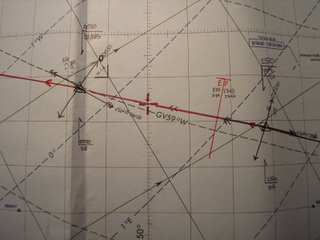In the age of the Jetliner, one no longer has to make several stops for fuel or rest on the way across the Pacific. Some of us, however, still do. In spite of the long hours this Pacific crossing took, I enjoyed it immensely. Of course, I'm glad to be flying once more; that bears little on my rather odd penchant for extended overwater navigation and for breaking out and using the sextant when there's a GPS right there.
To be sure, I still note down the GPS position each time I take a position fix, but in the case of this fix I waited until afterwards:

This fix was taken with a bearing and distance off a radio navigation aid at South Kauai (SOK), with a line of position from a sun observation with the sextant. The GPS plot was added as an afterthought, falling neatly into the pinpoint where the LOPs intersect. A very nice fix, and, in this case, the first of the day en route from Hawaii to Wake Island.
Also, at this time of year, Venus can be seen in broad daylight as long as you're using a telescope or a well dialed-in aircraft sextant, provided you know where to look. Good two-LOP celestial fixes in the middle of the day:

Venus, in Roman mythology, is a shockingly fickle goddess. The same can be said of the planet that bears her name. Its small orbit means that it moves across the sky very quickly, from being up a couple of hours after sunset to being up a couple of hours before sunrise in a matter of months or even weeks. During the day it can be a cast-iron bastard to spot, much less make a navigationally useful observation. All you can see through the sextant under the best circumstances, i.e. no clouds overhead and an unfogged objective prism in your instrument, is an easily-missed, miniscule speck of light. Even then, you have to have your sextant pre-set to the correct altitude angle, and have the correct azimuth dialed in to the plane's sextant mount. It takes months, if not years, of training and an inordinate amount of skill and practice to pull this off. Sadly, nobody teaches celestial aerial navigation anymore. Qualified Celestial-designated navigators are a dying breed and I'm proud to have been qualified in it before the training syllabus ceased. Some of my peers think I'm a little nutty to continue to be such a passionate advocate and enthusiastic user of these archaic techniques; I may be the only cel-qualified navigator to have actually used them in the last year or two.
In an earlier entry I posted a picture of a marine sextant, my inexpensive modern version of an instrument that has been in use for nearly 300 years. Here is its relatively modern (1940s vintage) aeronautical cousin, and in this case I am practically glued to it in the middle of an observation:

That about wraps it up for the flying side of this trip. Stick around for pictures from ground time...

No comments:
Post a Comment